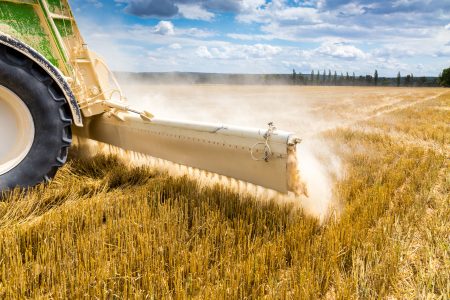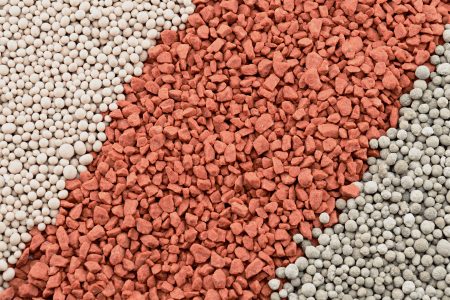Factors That Affect Uniform Fertilizer Application
Even distribution can directly impact crop yield.
Soil management is a key part of agriculture Best Management Practices (BMPs), within which fertilizer application is vital to increasing crop yields and sustaining them at high levels. Without it, the agricultural impact could be significant. One long-term field study based in Missouri found that 57% of grain yield resulted from lime and fertilizer application. And another study found that corn yields could decline by 40% when fertilizer is not used[1]. If there’s an even greater nutrient deficit, that yield reduction could be more, having a severe impact on farm revenues and on meeting global food demand, which is expected to increase by at least 59% by 2050[2].
It’s easy to see that fertilizer plays a key role in boosting crop yield, driving farmer incomes, and feeding a growing population; however, applying fertilizer is not as straightforward or simple as it sounds. There are many elements that can affect the efficacy of fertilizer, including even distribution during the application process.

Uniform fertilizer distribution is key to boosting crop yield.
Why uniform fertilizer application is important
Simply put, uniform fertilizer application is the only way to guarantee that vital nutrients are equally distributed to every crop. Conversely, uneven application can cause irregular growth, discoloring among crops, decreased yield, and low crop value.
Uniform fertilizer application is not just a preference or a “nice to do” – it is key to proper soil management.
5 factors that affect even fertilizer distribution
There are five key factors that influence fertilizer application to a great degree.
1. Granule uniformity
Granule uniformity is a crucial contributor to quality fertilizer. The importance of uniformity is twofold – it facilitates consistent nutrient distribution and even fertilizer application.

Granule uniformity is crucial: The more uniform the granules, the more likely they are to contain equal amounts of nutrients.
The more uniform the granules, the more likely they are to contain equal amounts of nutrients[3]. The less uniform the granule, the less predictable. A 2005 study from the American Society of Agricultural and Biological Engineers[4] found that there was virtually no difference in the chemical makeup of fertilizer granules as long as they were the same size.
In addition to inconsistent nutrient make-up, when the granules are different shapes and sizes, the fertilizer doesn’t flow as easily, making an even spread more difficult to achieve. Uneven distribution means some crops will receive nutrition while others are neglected.
Low uniformity is more likely to happen once fertilizer ages because the granules can degrade as they get older. To improve the chances your fertilizer granules are uniform, use fertilizer as close to the date of manufacture as possible. The closer the production date, the higher the likelihood the fertilizer will be in peak shape. Also — though harder to control — purchasing fertilizer made from the same manufacturing batch is a great way to ensure consistency in the shape and size of your granules[5].
2. Caking and clumping
Caking is a sign that humidity has invaded your fertilizer. Most farmers understand the downside of caked or clumped product – it’s less effective and, in many cases, its quality is compromised. Should you need to apply caked fertilizer, an even spread is nearly impossible and can result in overfertilization and loss of important crop nutrients.
Caked fertilizer causes a buildup of residue in your fertilizer spreader, especially in spots like the spiral cones, the agitator, and the impeller. This means that you’ll need to use more force to achieve the same volume of spread, and you’ll likely see a reduced delivery rate[6]. You’ll also need to recalibrate your spreader more frequently. You may even need to use an abrasive or solvent to effectively remove the buildup. All these issues result in additional time, resources, and financial costs and still do not ensure even fertilizer application.
3. Micronutrient/macronutrient segregation
In nutrient segregation, micronutrients and macronutrients are either unevenly bound or not bound to each other at all. If unbound, the micronutrients often settle to the bottom of the product, so when the fertilizer is applied, the nutrients are not evenly distributed across the planting area.
There are three primary types of nutrient segregation[7]:
- Ballistic segregation – The spreader tends to toss heavier granules further, which comes into play when the granules are blended from particles that are different sizes or weights.
- Coning segregation – Heavy granules fall to the bottom of the fertilizer pile, so granules made from materials of different sizes, shapes, and densities are likely to separate.
- Sifting segregation – Fertilizer sifting tends to happen during long periods of transport.
Regardless of the type of segregation, the unbinding of macronutrients and micronutrients leads to nutrient-deficient crops and lower yields.
4. Subsoil compaction
Compaction may help strengthen soil, but the more compacted it is, the more difficult it is to spread fertilizer evenly. With a lot of compaction, fertilizer may not penetrate the soil[8] or reach all crops, as it bounces around and lands in random ways. It’s critical that farmers assess this early on and address root-soil dynamics and nutrient movement to ensure the most even distribution possible.
5. Fertilizer spreader
The fertilizer spreader certainly plays an important role in even fertilizer application. First, you need to choose the right spreader. There are three main types to consider – rotary spreaders, drop spreaders, and liquid spreaders. The one you decide on depends on the amount of land you need to cover and the type of fertilizer you are using. Drop and liquid spreaders tend to work best for even, precise applications[9]. Rotary spreaders spread fertilizer over longer distances but do not follow any particular flow patterns.

Selecting the right spreader and using the right maintenance and application procedures directly impact successful fertilizer application.
After selecting the spreader, be sure to observe application best practices, such as using the right speed and gear for constant application, driving the correct working width, and heeding field margins to ensure you load enough fertilizer. Also, regular maintenance is key to prevent buildup or breakdown of parts.
Conclusion
Uniform fertilizer distribution is one of the best ways to protect and improve your crop yield. While not all factors can be completely controlled, by taking the time to adhere to BMPs, manage your fertilizer quality, and maintain your spreader, you can help reduce unpredictable results.
MinTech can help, too. The products in the MinTerra line are all designed to prevent the issues that make even application difficult. DustAid controls fertilizer dust so product isn’t weakened or wasted, CakeBrake provides long-lasting anti-caking support, and MicroBind improves the durability and solubility performance of fertilizer blends.
Visit mintech.com/minterra/ to learn more.
[1] Mikkelsen, Rob. (2019). Understanding Fertilizer and Its Essential Role in High-Yielding Crops. Retrieved from: https://www.cropnutrition.com/understanding-fertilizer-and-its-essential-role-in-high-yielding-crops?7258dda8-3796-4e4a-aa05-5362a445b6ab=0
[2] Elferink, Maarten and Schierhorn, Florian. (April 7, 2016). Global Demand for Food Is Rising. Can We Meet It? Retrieved from: https://hbr.org/2016/04/global-demand-for-food-is-rising-can-we-meet-it
[3] Isleib, Jim (December 29, 2016). Pros and cons of granular and liquid fertilizers. Retrieved from: https://www.canr.msu.edu/news/pros_and_cons_of_granular_and_liquid_fertilizers
[4] Smith, D.B., Willcutt, M.H., and Diallo, Y. (2005). Uniformity Of Size And Content Of Granular Fertilizers. Retrieved from: https://elibrary.asabe.org/abstract.asp??JID=3&AID=18562&CID=aeaj2005&v=21&i=4&T=1
[5] Searle, Sam. (June 1, 2018). 5 Tips For Effective Fertiliser Spreading. Retrieved from: https://www.rataequipment.com/blog/5-tips-for-effective-fertiliser-spreading
[6] Parish, Richard L. (1998). Granular Spreaders: Selection, Calibration, Testing, and Use. Retrieved from: https://www.lsuagcenter.com/NR/rdonlyres/D9458BB7-D852-40B4-B434-5A6FC0C43E0E/3925/B868.pdf
[7] Simplot Partners. (2019). The Benefits of Homogeneous Granular Fertilizer. Retrieved from: http://partners.simplot.com/education/2018/03/08/benefits-of-homogeneous-granular-fertilizer
[8] Searle, Sam. (June 1, 2018). 5 Tips For Effective Fertiliser Spreading. Retrieved from: https://www.rataequipment.com/blog/5-tips-for-effective-fertiliser-spreading
[9] Framing Nailers Guide. (2019). 4 Types of Fertilizer Spreaders Explained by Real User. Retrieved from: https://framingnailersguide.com/types-of-fertilizer-spreaders/
